The Cambridge History of Japan, Vol. 3: Medieval Japan
Подождите немного. Документ загружается.

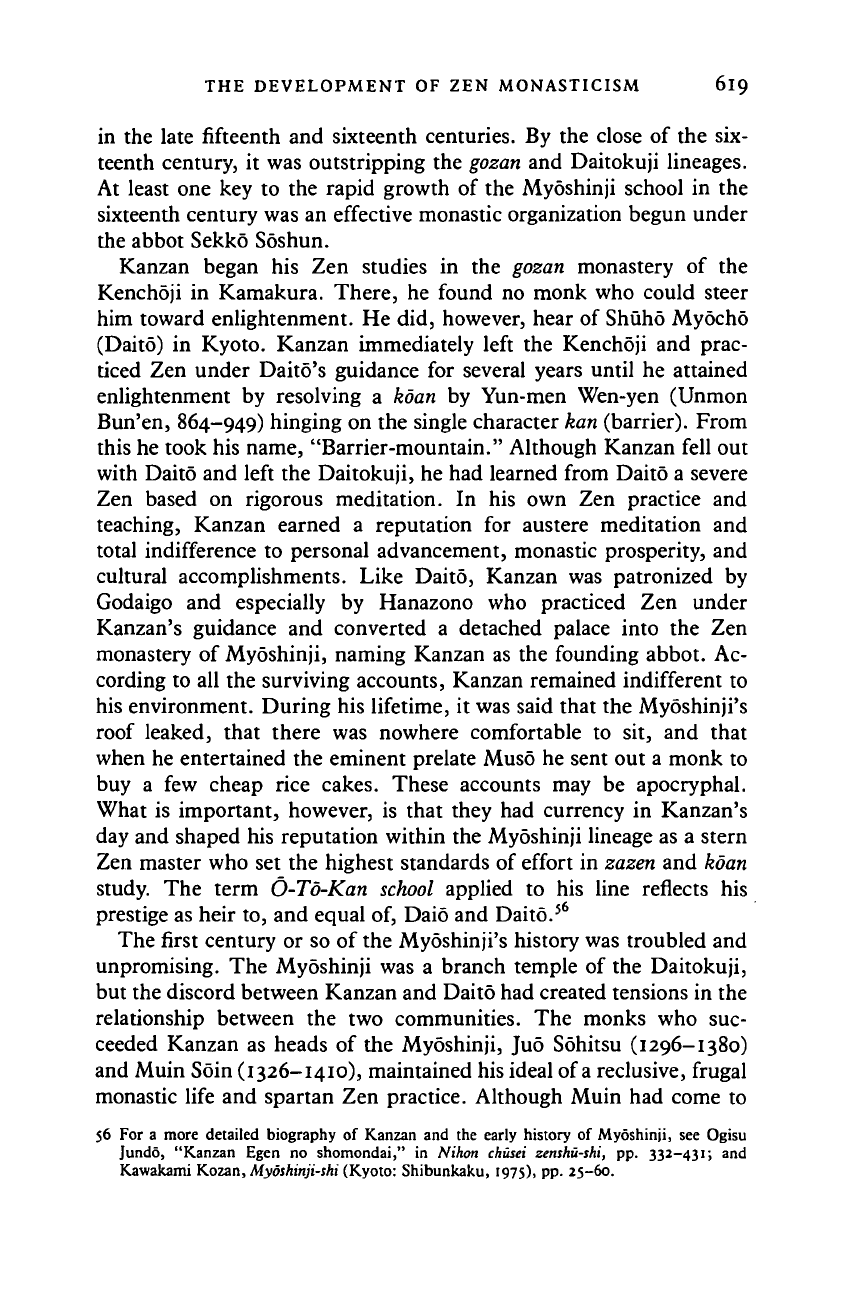
THE DEVELOPMENT OF ZEN MONASTICISM 619
in the late fifteenth and sixteenth centuries. By the close of the six-
teenth century, it was outstripping the
gozan
and Daitokuji lineages.
At least one key to the rapid growth of the Myoshinji school in the
sixteenth century was an effective monastic organization begun under
the abbot Sekko Soshun.
Kanzan began his Zen studies in the gozan monastery of the
Kenchoji in Kamakura. There, he found no monk who could steer
him toward enlightenment. He did, however, hear of Shuho Myocho
(Daito) in Kyoto. Kanzan immediately left the Kenchoji and prac-
ticed Zen under Daito's guidance for several years until he attained
enlightenment by resolving a koan by Yun-men Wen-yen (Unmon
Bun'en, 864-949) hinging on the single character kan (barrier). From
this he took his name, "Barrier-mountain." Although Kanzan fell out
with Daito and left the Daitokuji, he had learned from Daito a severe
Zen based on rigorous meditation. In his own Zen practice and
teaching, Kanzan earned a reputation for austere meditation and
total indifference to personal advancement, monastic prosperity, and
cultural accomplishments. Like Daito, Kanzan was patronized by
Godaigo and especially by Hanazono who practiced Zen under
Kanzan's guidance and converted a detached palace into the Zen
monastery of Myoshinji, naming Kanzan as the founding abbot. Ac-
cording to all the surviving accounts, Kanzan remained indifferent to
his environment. During his lifetime, it was said that the Myoshinji's
roof leaked, that there was nowhere comfortable to sit, and that
when he entertained the eminent prelate Muso he sent out a monk to
buy a few cheap rice cakes. These accounts may be apocryphal.
What is important, however, is that they had currency in Kanzan's
day and shaped his reputation within the Myoshinji lineage as a stern
Zen master who set the highest standards of effort in zazen and koan
study. The term O-To-Kan school applied to his line reflects his
prestige as heir to, and equal of, Daio and Daito.
56
The first century or so of the Myoshinji's history was troubled and
unpromising. The Myoshinji was a branch temple of the Daitokuji,
but the discord between Kanzan and Daito had created tensions in the
relationship between the two communities. The monks who suc-
ceeded Kanzan as heads of the Myoshinji, Juo Sohitsu (1296-1380)
and Muin Soin (1326-1410), maintained his ideal of a reclusive, frugal
monastic life and spartan Zen practice. Although Muin had come to
56 For a more detailed biography of Kanzan and the early history of Myoshinji, see Ogisu
Jundo, "Kanzan Egen no shomondai," in Nihon chusei zenshu-shi, pp.
332-431;
and
Kawakami Kozan, Myoshinji-shi (Kyoto: Shibunkaku, 1975), pp. 25-60.
Cambridge Histories Online © Cambridge University Press, 2008
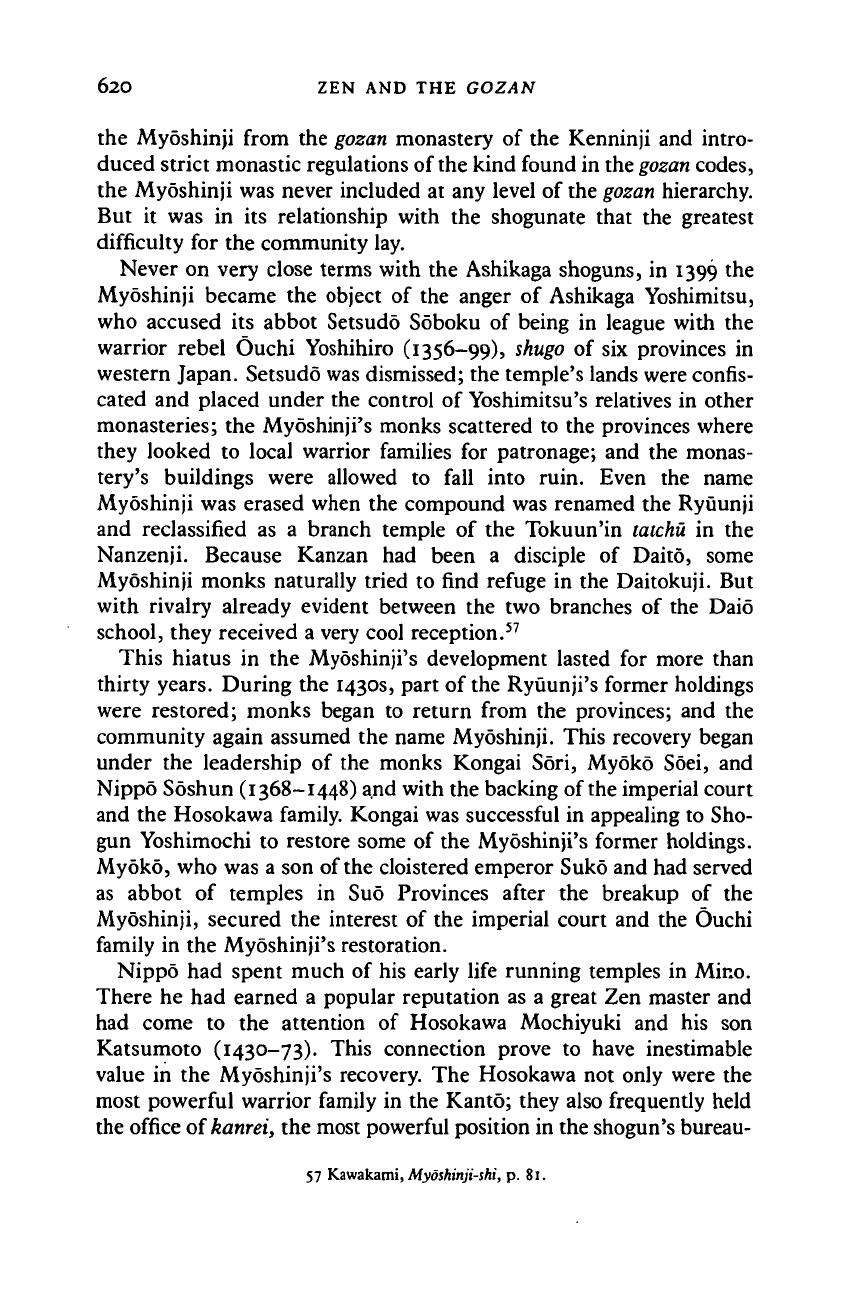
62O ZEN AND THE GOZAN
the Myoshinji from the
gozan
monastery of the Kenninji and intro-
duced strict monastic regulations of
the
kind found in the
gozan
codes,
the Myoshinji was never included at any level of the
gozan
hierarchy.
But it was in its relationship with the shogunate that the greatest
difficulty for the community lay.
Never on very close terms with the Ashikaga shoguns, in 1399 the
Myoshinji became the object of the anger of Ashikaga Yoshimitsu,
who accused its abbot Setsudo Soboku of being in league with the
warrior rebel Ouchi Yoshihiro (1356-99),
shugo
of six provinces in
western Japan. Setsudo was dismissed; the temple's lands were confis-
cated and placed under the control of Yoshimitsu's relatives in other
monasteries; the Myoshinji's monks scattered to the provinces where
they looked to local warrior families for patronage; and the monas-
tery's buildings were allowed to fall into ruin. Even the name
Myoshinji was erased when the compound was renamed the Ryuunji
and reclassified as a branch temple of the Tokuun'in
taichu
in the
Nanzenji. Because Kanzan had been a disciple of Daito, some
Myoshinji monks naturally tried to find refuge in the Daitokuji. But
with rivalry already evident between the two branches of the Daio
school, they received a very cool reception.
57
This hiatus in the Myoshinji's development lasted for more than
thirty years. During the 1430s, part of the Ryuunji's former holdings
were restored; monks began to return from the provinces; and the
community again assumed the name Myoshinji. This recovery began
under the leadership of the monks Kongai Sori, Myoko Soei, and
Nippo Soshun (1368-1448) and with the backing of
the
imperial court
and the Hosokawa family. Kongai was successful in appealing to Sho-
gun Yoshimochi to restore some of the Myoshinji's former holdings.
Myoko, who was a son of
the
cloistered emperor Suko and had served
as abbot of temples in Suo Provinces after the breakup of the
Myoshinji, secured the interest of the imperial court and the Ouchi
family in the Myoshinji's restoration.
Nippo had spent much of his early life running temples in Mino.
There he had earned a popular reputation as a great Zen master and
had come to the attention of Hosokawa Mochiyuki and his son
Katsumoto (1430-73). This connection prove to have inestimable
value in the Myoshinji's recovery. The Hosokawa not only were the
most powerful warrior family in the Kanto; they also frequently held
the office oikanrei, the most powerful position in the shogun's bureau-
57 Kawakami, Myoshinji-shi, p. 81.
Cambridge Histories Online © Cambridge University Press, 2008
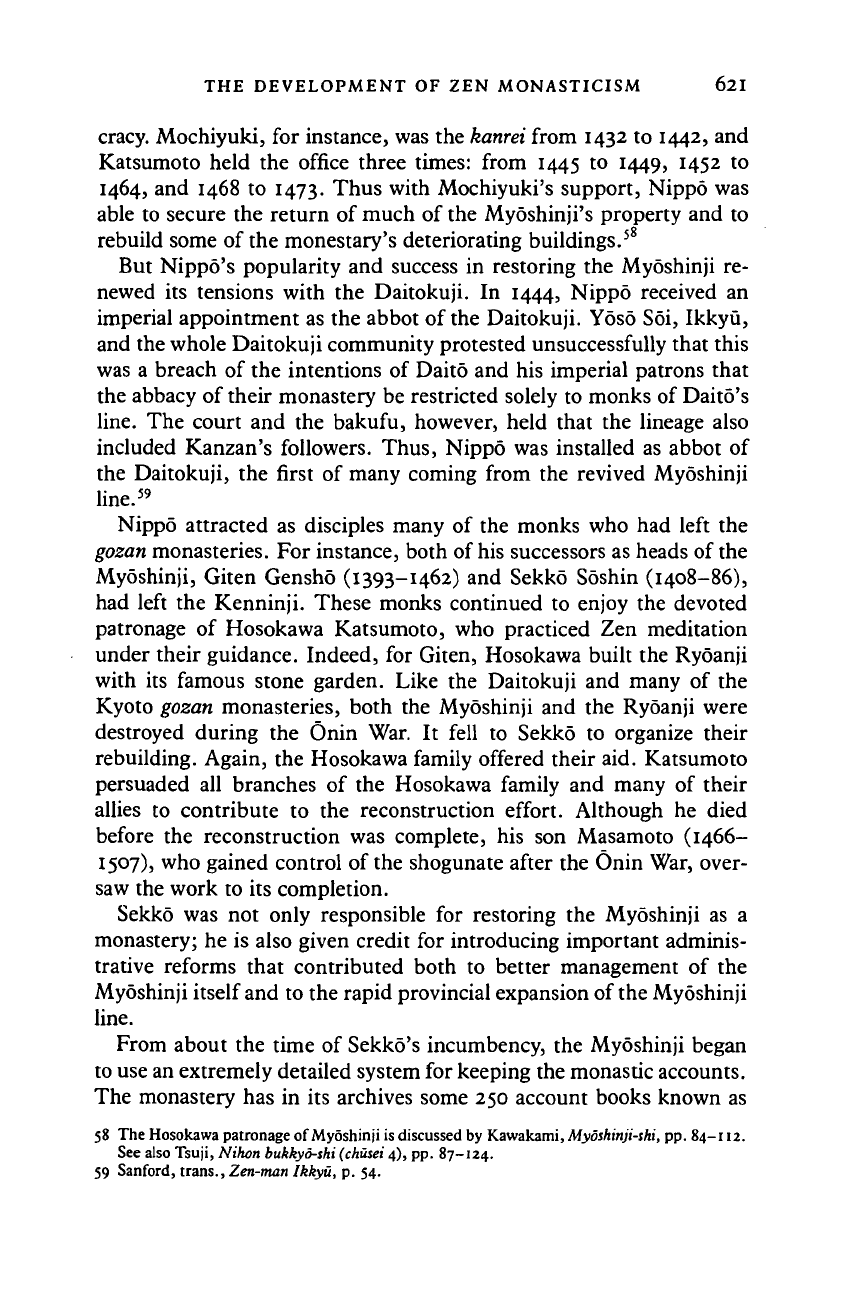
THE DEVELOPMENT OF ZEN MONASTICISM 621
cracy. Mochiyuki, for instance, was the
kanrei
from 1432 to 1442, and
Katsumoto held the office three times: from 1445 to 1449, 1452 to
1464,
and 1468 to 1473. Thus with Mochiyuki's support, Nippo was
able to secure the return of much of the Myoshinji's property and to
rebuild some of the monestary's deteriorating buildings.
58
But Nippo's popularity and success in restoring the Myoshinji re-
newed its tensions with the Daitokuji. In 1444, Nippo received an
imperial appointment as the abbot of the Daitokuji. Yoso Soi, Ikkyu,
and the whole Daitokuji community protested unsuccessfully that this
was a breach of the intentions of Daito and his imperial patrons that
the abbacy of their monastery be restricted solely to monks of Daito's
line.
The court and the bakufu, however, held that the lineage also
included Kanzan's followers. Thus, Nippo was installed as abbot of
the Daitokuji, the first of many coming from the revived Myoshinji
line.
59
Nippo attracted as disciples many of the monks who had left the
gozan
monasteries. For instance, both of
his
successors as heads of the
Myoshinji, Giten Gensho (1393-1462) and Sekko Soshin (1408-86),
had left the Kenninji. These monks continued to enjoy the devoted
patronage of Hosokawa Katsumoto, who practiced Zen meditation
under their guidance. Indeed, for Giten, Hosokawa built the Ryoanji
with its famous stone garden. Like the Daitokuji and many of the
Kyoto
gozan
monasteries, both the Myoshinji and the Ryoanji were
destroyed during the Onin War. It fell to Sekko to organize their
rebuilding. Again, the Hosokawa family offered their aid. Katsumoto
persuaded all branches of the Hosokawa family and many of their
allies to contribute to the reconstruction effort. Although he died
before the reconstruction was complete, his son Masamoto (1466-
1507),
who gained control of the shogunate after the Onin War, over-
saw the work to its completion.
Sekko was not only responsible for restoring the Myoshinji as a
monastery; he is also given credit for introducing important adminis-
trative reforms that contributed both to better management of the
Myoshinji itself and to the rapid provincial expansion of the Myoshinji
line.
From about the time of Sekko's incumbency, the Myoshinji began
to use an extremely detailed system for keeping the monastic accounts.
The monastery has in its archives some 250 account books known as
58 The Hosokawa patronage of Myoshinji is discussed by Kavvakami, Myoshinji-shi, pp. 84-112.
See also Tsuji, Nihon bukkyo-shi (chusei 4), pp. 87-124.
59 Sanford, trans., Zen-man Ikkyu, p. 54.
Cambridge Histories Online © Cambridge University Press, 2008
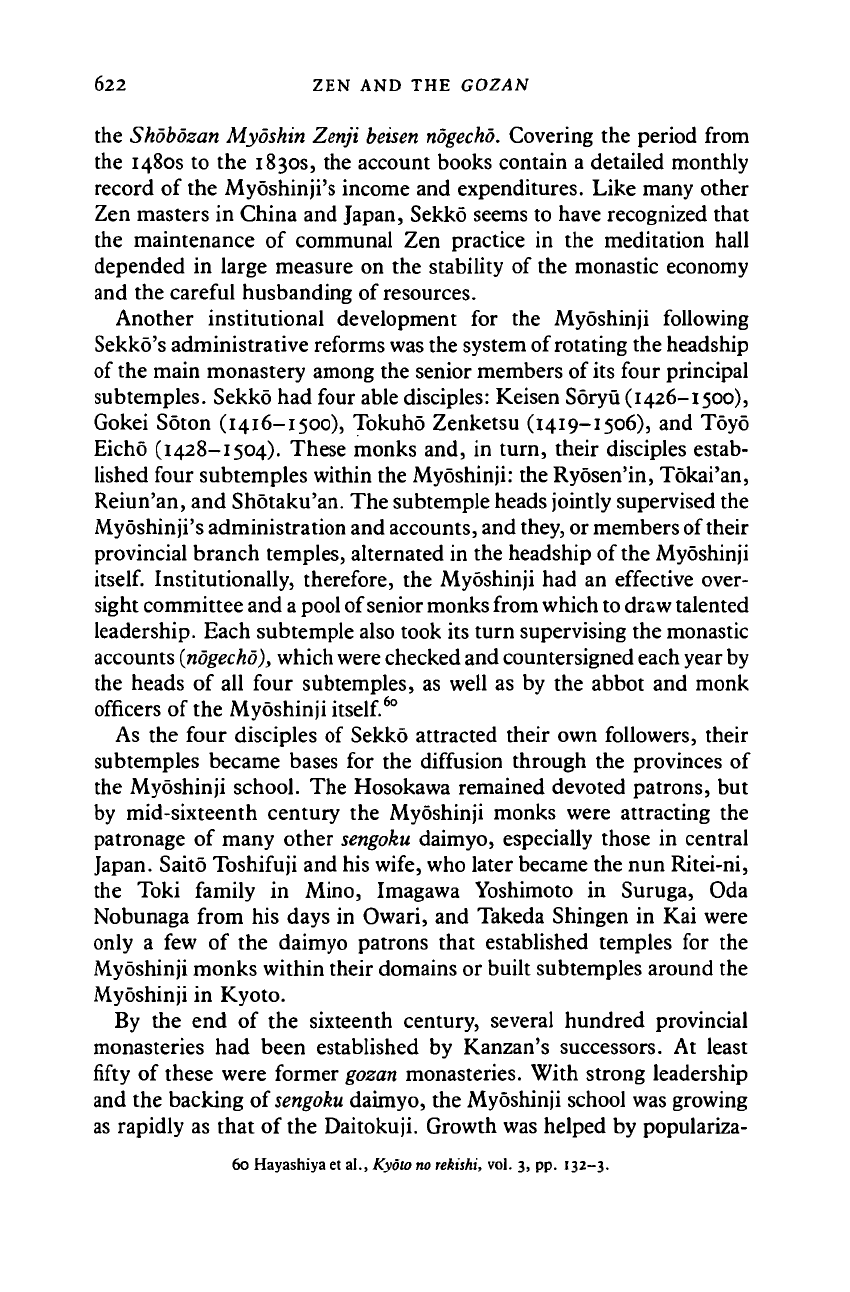
622
ZEN AND THE
GOZAN
the Shobozan Myoshin Zenji
beisen
nogecho.
Covering
the
period from
the 1480s
to the
1830s,
the
account books contain
a
detailed monthly
record
of the
Myoshinji's income
and
expenditures. Like many other
Zen masters
in
China
and
Japan, Sekko seems
to
have recognized that
the maintenance
of
communal
Zen
practice
in the
meditation hall
depended
in
large measure
on the
stability
of the
monastic economy
and
the
careful husbanding
of
resources.
Another institutional development
for the
Myoshinji following
Sekko's administrative reforms was
the
system of rotating the headship
of the main monastery among
the
senior members
of
its
four principal
subtemples. Sekko
had
four able disciples: Keisen Soryu (1426-1500),
Gokei Soton (1416-1500), Tokuho Zenketsu (1419-1506),
and
Toyo
Eicho (1428-1504). These monks
and, in
turn, their disciples estab-
lished four subtemples within
the
Myoshinji:
the
Ryosen'in, Tokai'an,
Reiun'an,
and
Shotaku'an.
The
subtemple heads jointly supervised
the
Myoshinji's administration and accounts, and they, or members of their
provincial branch temples, alternated
in the
headship
of
the
Myoshinji
itself.
Institutionally, therefore,
the
Myoshinji
had an
effective over-
sight committee and
a
pool of senior
monks
from which
to
draw talented
leadership. Each subtemple also took
its
turn supervising
the
monastic
accounts
{nogecho),
which
were
checked and countersigned each year by
the heads
of all
four subtemples,
as
well
as by the
abbot
and
monk
officers
of
the Myoshinji
itself.
60
As
the
four disciples
of
Sekko attracted their
own
followers, their
subtemples became bases
for the
diffusion through
the
provinces
of
the Myoshinji school.
The
Hosokawa remained devoted patrons,
but
by mid-sixteenth century
the
Myoshinji monks were attracting
the
patronage
of
many other
sengoku
daimyo, especially those
in
central
Japan. Saito Toshifuji
and his
wife, who later became
the nun
Ritei-ni,
the Toki family
in
Mino, Imagawa Yoshimoto
in
Suruga,
Oda
Nobunaga from
his
days
in
Owari,
and
Takeda Shingen
in Kai
were
only
a few of the
daimyo patrons that established temples
for the
Myoshinji monks within their domains
or
built subtemples around
the
Myoshinji
in
Kyoto.
By
the end of the
sixteenth century, several hundred provincial
monasteries
had
been established
by
Kanzan's successors.
At
least
fifty of these were former
gozan
monasteries. With strong leadership
and
the
backing
of
sengoku
daimyo,
the
Myoshinji school was growing
as rapidly
as
that
of the
Daitokuji. Growth
was
helped
by
populariza-
60 Hayashiya
et al.,
Kyoto no rekishi,
vol. 3, pp.
132-3.
Cambridge Histories Online © Cambridge University Press, 2008
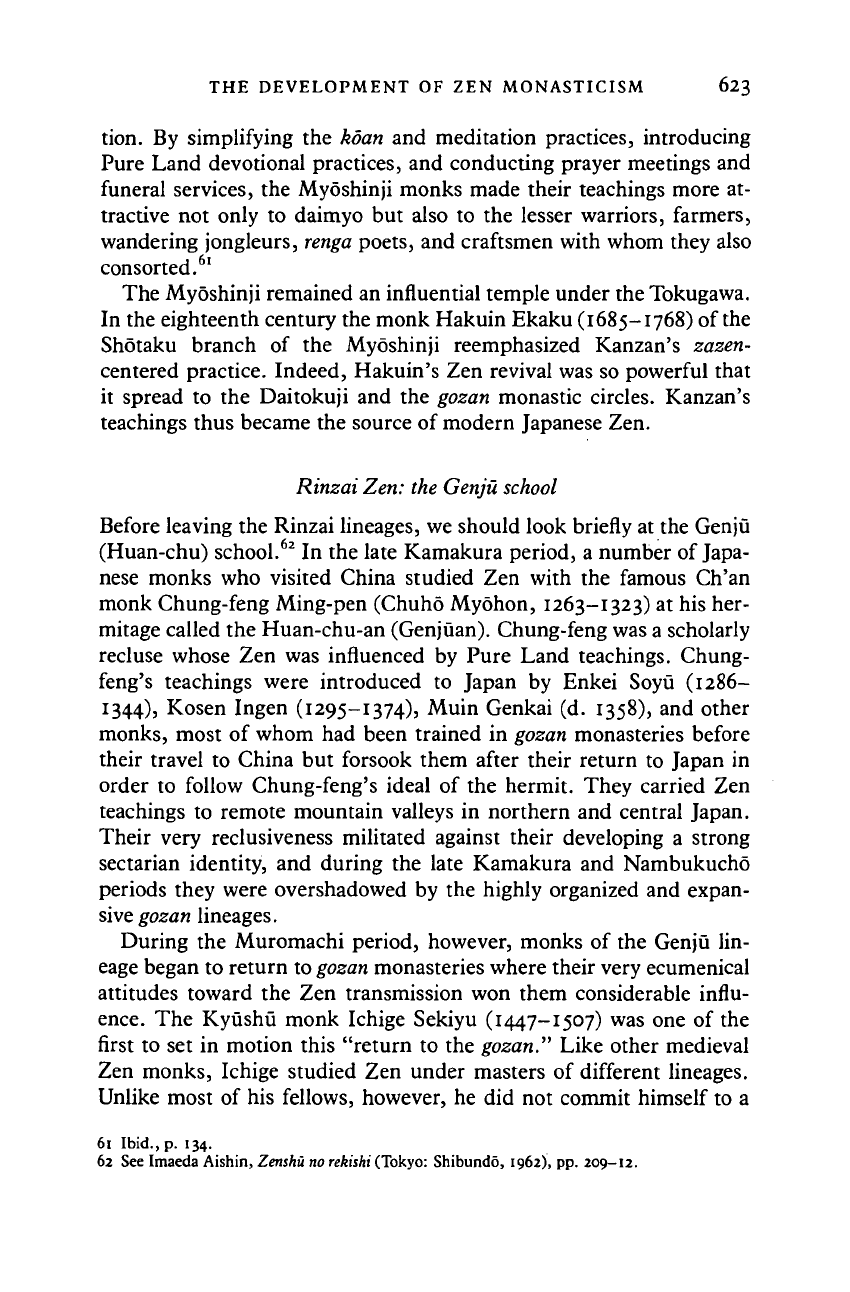
THE DEVELOPMENT OF ZEN MONASTICISM 623
tion. By simplifying the kdan and meditation practices, introducing
Pure Land devotional practices, and conducting prayer meetings and
funeral services, the Myoshinji monks made their teachings more at-
tractive not only to daimyo but also to the lesser warriors, farmers,
wandering jongleurs,
renga
poets, and craftsmen with whom they also
consorted.
61
The Myoshinji remained an influential temple under the Tokugawa.
In the eighteenth century the monk Hakuin Ekaku (1685-1768) of the
Shotaku branch of the Myoshinji reemphasized Kanzan's zazen-
centered practice. Indeed, Hakuin's Zen revival was so powerful that
it spread to the Daitokuji and the gozan monastic circles. Kanzan's
teachings thus became the source of modern Japanese Zen.
Rinzai Zen: the Genju
school
Before leaving the Rinzai lineages, we should look briefly at the Genju
(Huan-chu) school.
62
In the late Kamakura period, a number of Japa-
nese monks who visited China studied Zen with the famous Ch'an
monk Chung-feng Ming-pen (Chuho Myohon, 1263-1323) at his her-
mitage called the Huan-chu-an (Genjuan). Chung-feng was a scholarly
recluse whose Zen was influenced by Pure Land teachings. Chung-
feng's teachings were introduced to Japan by Enkei Soyu (1286-
1344),
Kosen Ingen (1295-1374), Muin Genkai (d. 1358), and other
monks, most of whom had been trained in gozan monasteries before
their travel to China but forsook them after their return to Japan in
order to follow Chung-feng's ideal of the hermit. They carried Zen
teachings to remote mountain valleys in northern and central Japan.
Their very reclusiveness militated against their developing a strong
sectarian identity, and during the late Kamakura and Nambukucho
periods they were overshadowed by the highly organized and expan-
sive gozan lineages.
During the Muromachi period, however, monks of the Genju lin-
eage began to return to gozan monasteries where their very ecumenical
attitudes toward the Zen transmission won them considerable influ-
ence.
The Kyushu monk Ichige Sekiyu (1447-1507) was one of the
first to set in motion this "return to the gozan." Like other medieval
Zen monks, Ichige studied Zen under masters of different lineages.
Unlike most of his fellows, however, he did not commit himself to a
61 Ibid., p. 134.
62 See Imaeda Aishin, Zenshu no rekishi (Tokyo: Shibundo, 1962), pp. 209-12.
Cambridge Histories Online © Cambridge University Press, 2008
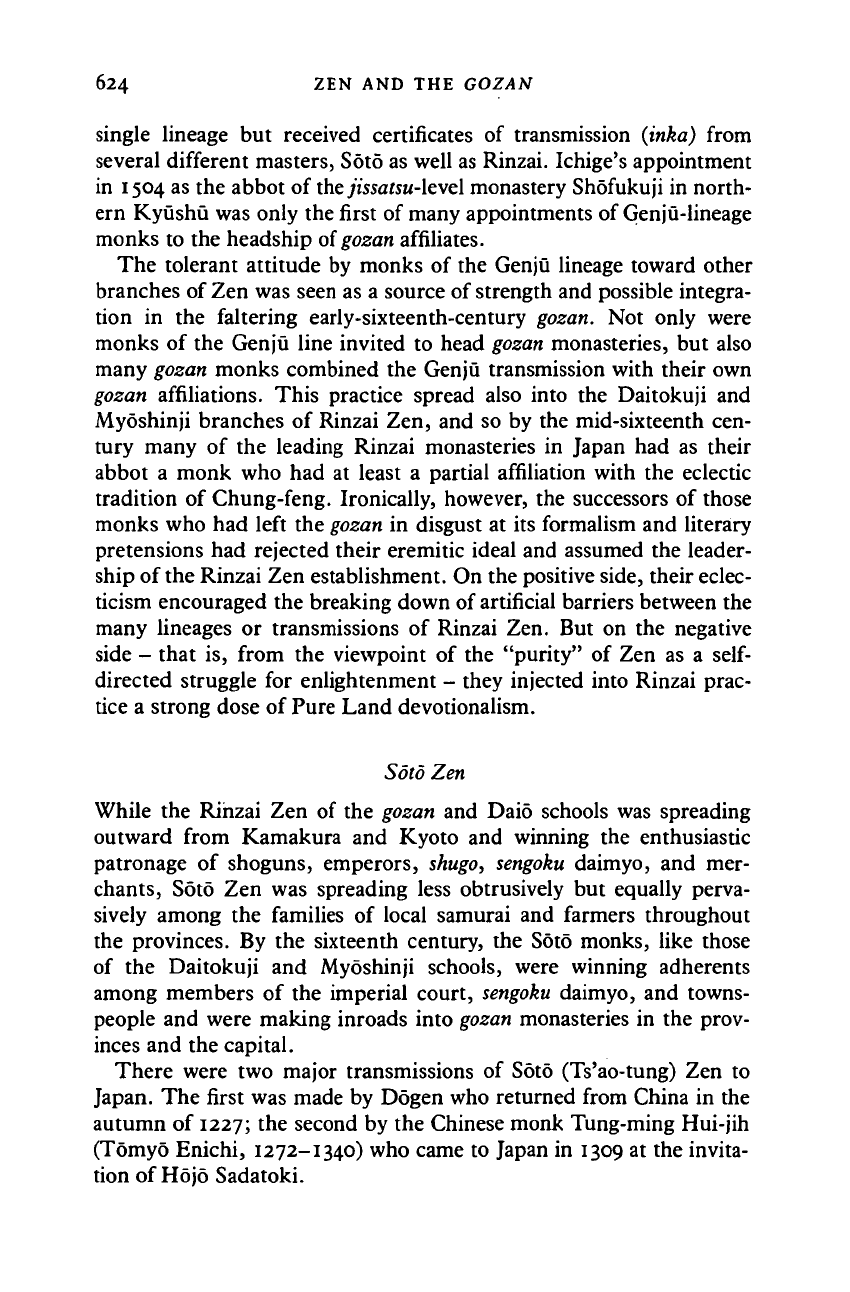
624 ZEN AND THE GOZAN
single lineage but received certificates of transmission (inka) from
several different masters, Soto as well as Rinzai. Ichige's appointment
in 1504 as the abbot of the
jissatsu-level
monastery Shofukuji in north-
ern Kyushu was only the first of many appointments of Genju-lineage
monks to the headship of
gozan
affiliates.
The tolerant attitude by monks of the Genju lineage toward other
branches of Zen was seen as a source of strength and possible integra-
tion in the faltering early-sixteenth-century gozan. Not only were
monks of the Genju line invited to head
gozan
monasteries, but also
many
gozan
monks combined the Genju transmission with their own
gozan affiliations. This practice spread also into the Daitokuji and
Myoshinji branches of Rinzai Zen, and so by the mid-sixteenth cen-
tury many of the leading Rinzai monasteries in Japan had as their
abbot a monk who had at least a partial affiliation with the eclectic
tradition of Chung-feng. Ironically, however, the successors of those
monks who had left the
gozan
in disgust at its formalism and literary
pretensions had rejected their eremitic ideal and assumed the leader-
ship of the Rinzai Zen establishment. On the positive side, their eclec-
ticism encouraged the breaking down of artificial barriers between the
many lineages or transmissions of Rinzai Zen. But on the negative
side - that is, from the viewpoint of the "purity" of Zen as a
self-
directed struggle for enlightenment - they injected into Rinzai prac-
tice a strong dose of Pure Land devotionalism.
Soto Zen
While the Rinzai Zen of the gozan and Daio schools was spreading
outward from Kamakura and Kyoto and winning the enthusiastic
patronage of shoguns, emperors,
shugo,
sengoku
daimyo, and mer-
chants, Soto Zen was spreading less obtrusively but equally perva-
sively among the families of local samurai and farmers throughout
the provinces. By the sixteenth century, the Soto monks, like those
of the Daitokuji and Myoshinji schools, were winning adherents
among members of the imperial court,
sengoku
daimyo, and towns-
people and were making inroads into
gozan
monasteries in the prov-
inces and the capital.
There were two major transmissions of Soto (Ts'ao-tung) Zen to
Japan. The first was made by Dogen who returned from China in the
autumn of
1227;
the second by the Chinese monk Tung-ming Hui-jih
(Tomyo Enichi, 1272-1340) who came to Japan in 1309 at the invita-
tion of Hojo Sadatoki.
Cambridge Histories Online © Cambridge University Press, 2008

THE DEVELOPMENT OF ZEN MONASTICISM 625
The institutional development of Dogen's lineage during the medi-
eval period occurred in four fairly clear-cut stages. The first of these
covered Dogen's lifetime and included the establishment of the Koshoji
and Eiheiji communities and the compilation by Dogen of comprehen-
sive regulations for the monastic institution he had in mind. The sec-
ond, beginning around 1300, saw a sectarian schism among the third
generation of Dogen's followers and the growth of the Sojiji
as a
rival to
the Eiheiji. The third stage included the movement for the populariza-
tion of Soto Zen teachings and their widespread provincial diffusion
during the Muromachi period. The fourth stage witnessed the recovery
of the Eiheiji
as
the central temple
(honzan)
of
a
nationwide Soto school.
Dogen and the early
development
of Soto Zen
Dogen returned from China in 1227 convinced that the Zen practice of
concentrated meditation
(shikan
taza) that he had inherited from the
Ts'ao-tung master T'ien-t'ung Ju-ching was the "true Dharma"
(shdbd).
In the first works he wrote after his return to Japan, the
Fukan
zazengi
(Principles for the universal promotion of
zazen)
and
Bendowa
(Distinguishing the Way), he advocated zazen (seated meditation) as
the supreme Buddhist practice for both monks and laypersons.
63
This
assertion of the primacy of Zen aroused the anger of the Enryakuji
monks, who succeeded in driving Dogen from the Kenninji where he
had settled after his return to the capital.
In 1231, Dogen moved to Fukakusa, just south of Kyoto. There he
established the Koshoji. Dogen's strict training under Ju-ching had
made him an admirer of Zen monastic life as he believed it to have
been shaped by the regulations enforced by the T'ang-dynasty Ch'an
master Pai-chang. For some time after his return to Japan, Dogen held
an ideal of universal monkhood in the broadest terms. Enlightenment
through zazen, he argued in Fukan
zazengi,
was open to all men and
women, lay as well as clerical. And access to this enlightenment was
facilitated by the scrupulous, mindful observance of
the
Zen monastic
regulations.
In time, however, when Dogen was excluded from the capital -
confronted with the practical difficulty of spreading his teachings in
the face of bitter opposition from the established Buddhist schools,
deprived of elite patronage, and becoming more pessimistic about the
63 For translations of these two works, see Masao Abe and Norman Wadell, trans., "Dogen's
Bendowa,"
The Eastern
Buddhist 4 (May 1971): 124-57; and Masao Abe and Norman Wadell,
trans.,
"Dogen's Fukanzazengi," The
Eastern
Buddhist (October 1973): 121-6.
Cambridge Histories Online © Cambridge University Press, 2008
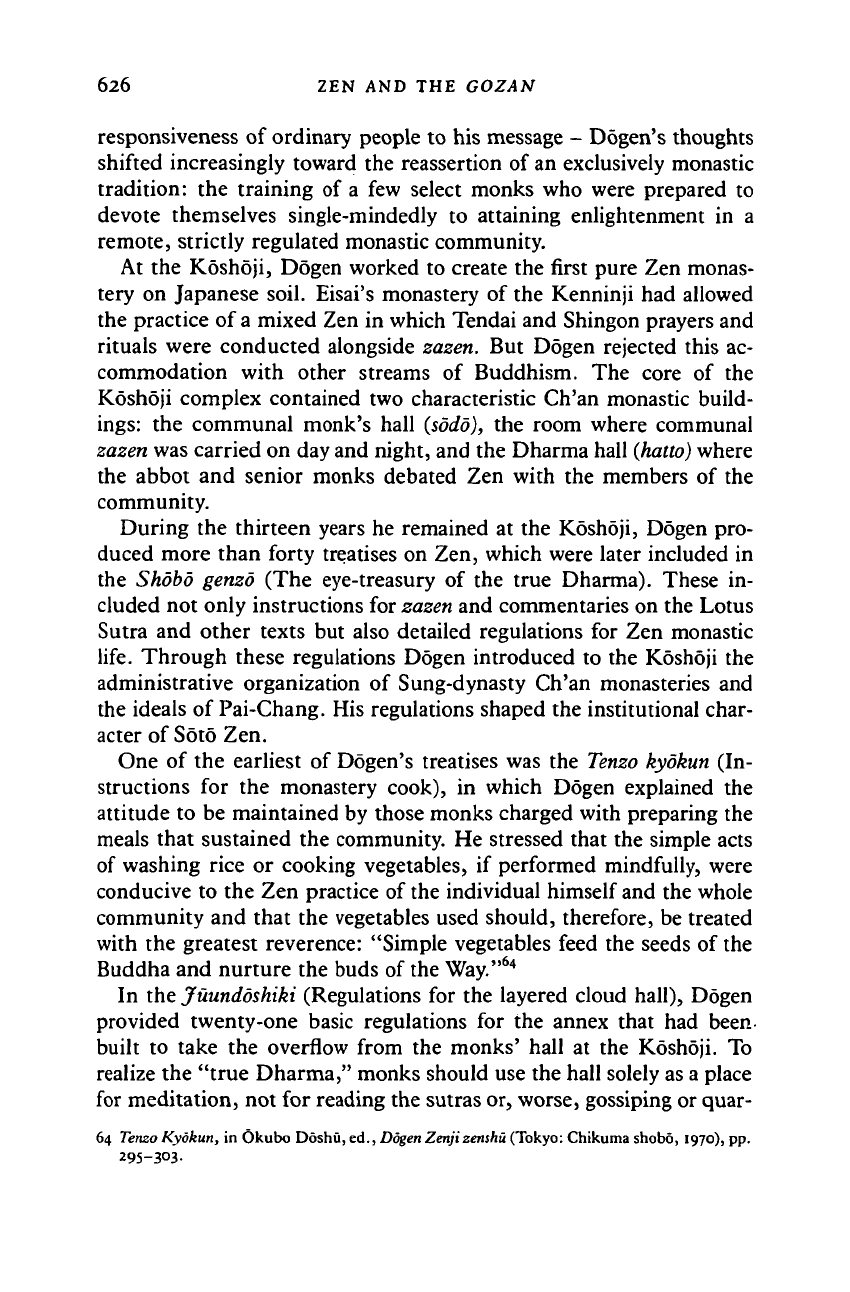
626 ZEN AND THE GOZAN
responsiveness of ordinary people to his message - Dogen's thoughts
shifted increasingly toward the reassertion of an exclusively monastic
tradition: the training of a few select monks who were prepared to
devote themselves single-mindedly to attaining enlightenment in a
remote, strictly regulated monastic community.
At the Koshoji, Dogen worked to create the first pure Zen monas-
tery on Japanese soil. Eisai's monastery of the Kenninji had allowed
the practice of
a
mixed Zen in which Tendai and Shingon prayers and
rituals were conducted alongside zazen. But Dogen rejected this ac-
commodation with other streams of Buddhism. The core of the
Koshoji complex contained two characteristic Ch'an monastic build-
ings:
the communal monk's hall
(sddo),
the room where communal
zazen was carried on day and night, and the Dharma hall
{hatto)
where
the abbot and senior monks debated Zen with the members of the
community.
During the thirteen years he remained at the Koshoji, Dogen pro-
duced more than forty treatises on Zen, which were later included in
the Shobo genzo (The eye-treasury of the true Dharma). These in-
cluded not only instructions for
zazen
and commentaries on the Lotus
Sutra and other texts but also detailed regulations for Zen monastic
life.
Through these regulations Dogen introduced to the Koshoji the
administrative organization of Sung-dynasty Ch'an monasteries and
the ideals of Pai-Chang. His regulations shaped the institutional char-
acter of Soto Zen.
One of the earliest of Dogen's treatises was the
Tenzo
kyokun (In-
structions for the monastery cook), in which Dogen explained the
attitude to be maintained by those monks charged with preparing the
meals that sustained the community. He stressed that the simple acts
of washing rice or cooking vegetables, if performed mindfully, were
conducive to the Zen practice of the individual himself and the whole
community and that the vegetables used should, therefore, be treated
with the greatest reverence: "Simple vegetables feed the seeds of the
Buddha and nurture the buds of the Way."
64
In the Juundoshiki (Regulations for the layered cloud hall), Dogen
provided twenty-one basic regulations for the annex that had been-
built to take the overflow from the monks' hall at the Koshoji. To
realize the "true Dharma," monks should use the hall solely as a place
for meditation, not for reading the sutras or, worse, gossiping or quar-
64 Tenzo Kyokun, in Okubo Doshu, ed., Dogen Zenjizenshu (Tokyo: Chikuma shobo, 1970), pp.
295-3O3-
Cambridge Histories Online © Cambridge University Press, 2008
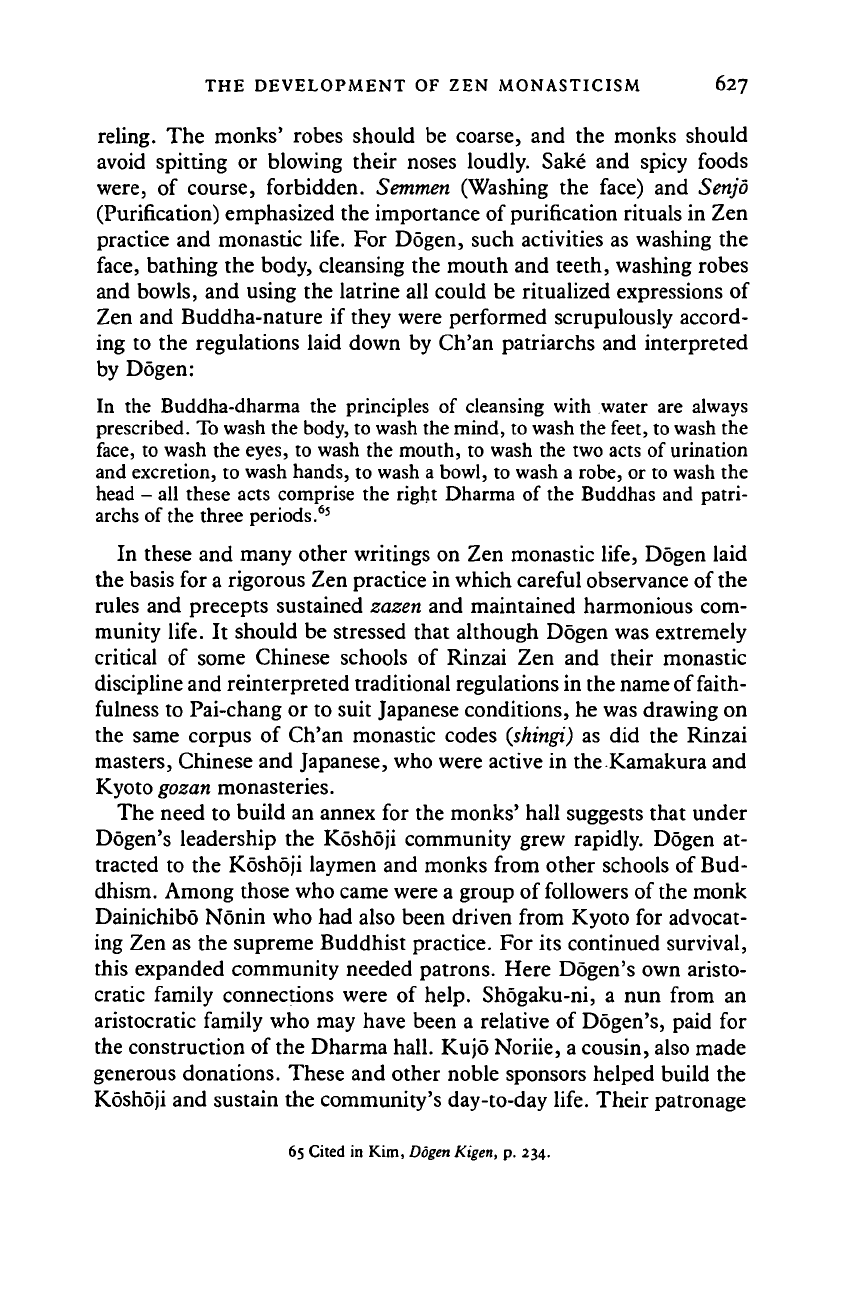
THE DEVELOPMENT OF ZEN MONASTICISM 627
reling. The monks' robes should be coarse, and the monks should
avoid spitting or blowing their noses loudly. Sake and spicy foods
were, of course, forbidden. Semmen (Washing the face) and Senjo
(Purification) emphasized the importance of purification rituals in Zen
practice and monastic life. For Dogen, such activities as washing the
face,
bathing the body, cleansing the mouth and teeth, washing robes
and bowls, and using the latrine all could be ritualized expressions of
Zen and Buddha-nature if they were performed scrupulously accord-
ing to the regulations laid down by Ch'an patriarchs and interpreted
by Dogen:
In the Buddha-dharma the principles of cleansing with water are always
prescribed. To wash the body, to wash the mind, to wash the feet, to wash the
face,
to wash the eyes, to wash the mouth, to wash the two acts of urination
and excretion, to wash hands, to wash a bowl, to wash a robe, or to wash the
head - all these acts comprise the right Dharma of the Buddhas and patri-
archs of the three periods.
65
In these and many other writings on Zen monastic life, Dogen laid
the basis for a rigorous Zen practice in which careful observance of the
rules and precepts sustained zazen and maintained harmonious com-
munity life. It should be stressed that although Dogen was extremely
critical of some Chinese schools of Rinzai Zen and their monastic
discipline and reinterpreted traditional regulations in the name of faith-
fulness to Pai-chang or to suit Japanese conditions, he was drawing on
the same corpus of Ch'an monastic codes (shingt) as did the Rinzai
masters, Chinese and Japanese, who were active in the Kamakura and
Kyoto gozan monasteries.
The need to build an annex for the monks' hall suggests that under
Dogen's leadership the Koshoji community grew rapidly. Dogen at-
tracted to the Koshoji laymen and monks from other schools of Bud-
dhism. Among those who came were a group of followers of the monk
Dainichibo Nonin who had also been driven from Kyoto for advocat-
ing Zen as the supreme Buddhist practice. For its continued survival,
this expanded community needed patrons. Here Dogen's own aristo-
cratic family connections were of help. Shogaku-ni, a nun from an
aristocratic family who may have been a relative of Dogen's, paid for
the construction of the Dharma hall. Kujo Noriie, a cousin, also made
generous donations. These and other noble sponsors helped build the
Koshoji and sustain the community's day-to-day life. Their patronage
65 Cited in Kim, Dogen Kigen, p. 234.
Cambridge Histories Online © Cambridge University Press, 2008
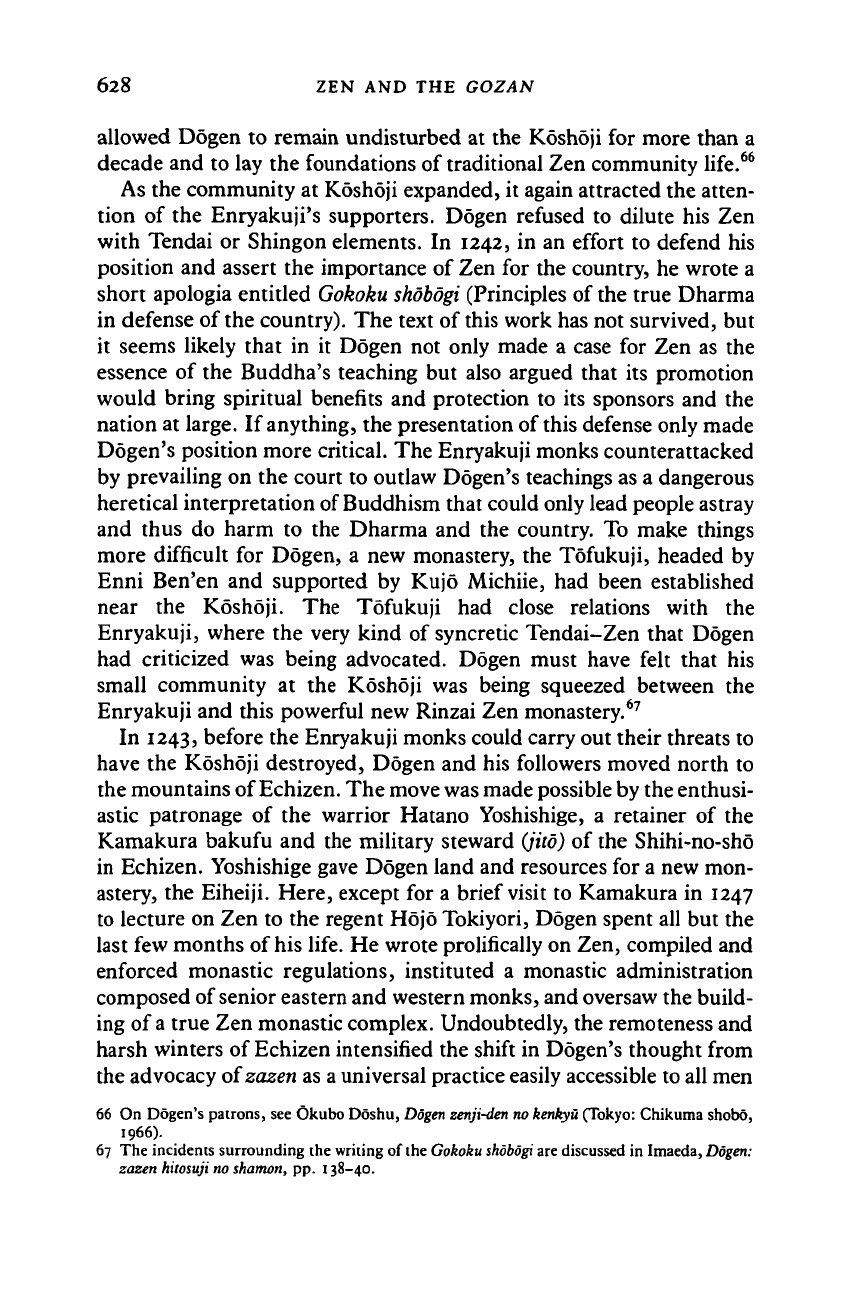
628 ZEN AND THE GOZAN
allowed Dogen to remain undisturbed at the Koshoji for more than a
decade and to lay the foundations of traditional Zen community life.
66
As the community at Koshoji expanded, it again attracted the atten-
tion of the Enryakuji's supporters. Dogen refused to dilute his Zen
with Tendai or Shingon elements. In 1242, in an effort to defend his
position and assert the importance of Zen for the country, he wrote a
short apologia entitled
Gokoku shobogi
(Principles of the true Dharma
in defense of the country). The text of this work has not survived, but
it seems likely that in it Dogen not only made a case for Zen as the
essence of the Buddha's teaching but also argued that its promotion
would bring spiritual benefits and protection to its sponsors and the
nation at large. If anything, the presentation of this defense only made
Dogen's position more critical. The Enryakuji monks counterattacked
by prevailing on the court to outlaw Dogen's teachings as a dangerous
heretical interpretation of Buddhism that could only lead people astray
and thus do harm to the Dharma and the country. To make things
more difficult for Dogen, a new monastery, the Tofukuji, headed by
Enni Ben'en and supported by Kujo Michiie, had been established
near the Koshoji. The Tofukuji had close relations with the
Enryakuji, where the very kind of syncretic Tendai-Zen that Dogen
had criticized was being advocated. Dogen must have felt that his
small community at the Koshoji was being squeezed between the
Enryakuji and this powerful new Rinzai Zen monastery.
67
In 1243, before the Enryakuji monks could carry out their threats to
have the Koshoji destroyed, Dogen and his followers moved north to
the mountains of Echizen. The move
was
made possible by the enthusi-
astic patronage of the warrior Hatano Yoshishige, a retainer of the
Kamakura bakufu and the military steward
(jito)
of the Shihi-no-sho
in Echizen. Yoshishige gave Dogen land and resources for a new mon-
astery, the Eiheiji. Here, except for a brief visit to Kamakura in 1247
to lecture on Zen to the regent Hojo Tokiyori, Dogen spent all but the
last few months of
his
life. He wrote prolifically on Zen, compiled and
enforced monastic regulations, instituted a monastic administration
composed of senior eastern and western monks, and oversaw the build-
ing of
a
true Zen monastic complex. Undoubtedly, the remoteness and
harsh winters of Echizen intensified the shift in Dogen's thought from
the advocacy of zazen as
a
universal practice easily accessible to all men
66 On Dogen's patrons, see Okubo Doshu, Dogen zenji-den no
kenkyu
(Tokyo: Chikuma shobo,
1966).
67 The incidents surrounding the writing of the Gokoku
shobogi
are discussed in Imaeda,
Dogen:
zazen
hitosuji
no
shamon,
pp. 138-40.
Cambridge Histories Online © Cambridge University Press, 2008
